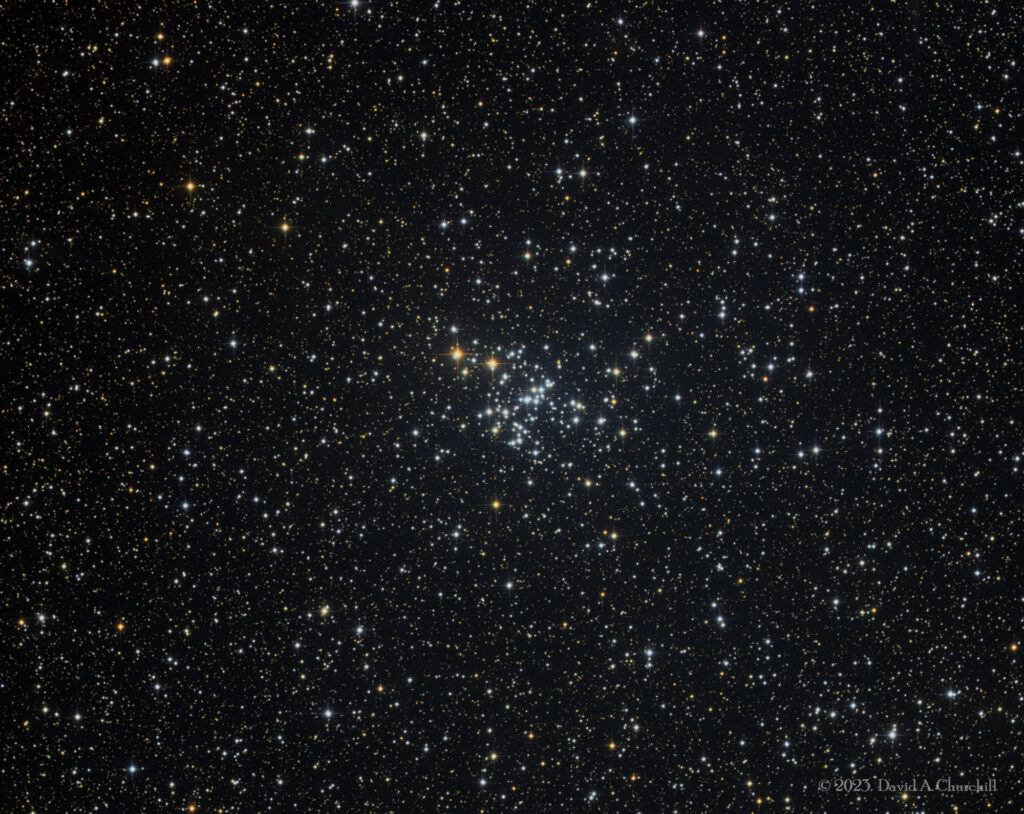Messier 93
Open Cluster, Puppis
- Description
- Technical
- Links
Messier 93 or M93, also known as NGC 2447, is an open cluster in the southern constellation Puppis, the imagined poop deck of the legendary Argo. It was discovered by Charles Messier then added to his catalogue of comet-like objects in 1781. Caroline Herschel, the younger sister of William Herschel, independently discovered it in 1783, thinking it had not yet been catalogued by Messier It has a Trumpler class of I 3 r, indicating it is strongly concentrated (I) with a large range in brightness (3) and is rich in stars (r).
M93 is about 3,380light-years from the solar radius and has a great spatial radius of 5 light-years, a tidal radius of 13.1±2.3 ly, and a core radius of 4.2 ly. Its age is estimated at 387.3 million years. It is nearly on the galactic plane and has an orbit that varies between 28–29 kly (8.5–8.9 kpc) from the Galactic Center over a period of 242.7±7.9 Myr.
Fifty-four variable stars have been found in M93, including one slowly pulsating B-type star, one rotating ellipsoidal variable, seven Delta Scuti variables, six Gamma Doradus variables, and one hybrid δ Sct/γ Dor pulsator. Four spectroscopic binary systems within include a yellow straggler component.
M93 is about 3,380light-years from the solar radius and has a great spatial radius of 5 light-years, a tidal radius of 13.1±2.3 ly, and a core radius of 4.2 ly. Its age is estimated at 387.3 million years. It is nearly on the galactic plane and has an orbit that varies between 28–29 kly (8.5–8.9 kpc) from the Galactic Center over a period of 242.7±7.9 Myr.
Fifty-four variable stars have been found in M93, including one slowly pulsating B-type star, one rotating ellipsoidal variable, seven Delta Scuti variables, six Gamma Doradus variables, and one hybrid δ Sct/γ Dor pulsator. Four spectroscopic binary systems within include a yellow straggler component.
Telescope: Planewave CDK17 (FR) f4.5
Mount: Astro Physics 1600GTO
Camera: QHY16200A/ Integral FW
Guider: Agena Starguide II / ZWO ASI178MM
Filters: Astronomik 36mm LRGB
L: 49×5 mins = 245 mins, R: 24×5 mins = 120 mins, G: 24×5 mins = 120 mins, B: 24×5 mins = 120 mins
Total Imaging Time: 10h 05m
Data Imaged remotely over 3 nights during February 2023.
Imaged from Observatorio El Sauce, Chile, in partnership with Fred Espenak.
Data acquisition & Processing by David Churchill.
None

